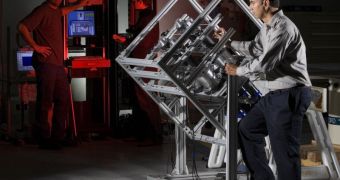The shocking 9/11 attacks brought back into attention the threat posed by a possible nuclear attack in the United States. In an effort to better detect the smuggle of nuclear material, researchers at Sandia National Laboratories in California designed a new neutron detector, which is effective over larger distances and can detect radiation emitted from radioactive material even through heavy shielding, and could even point to the location from which the radiation is emitted.
The device, called the neutron scatter camera, has been specially designed to replace the old gamma-ray and neutron detectors, which are currently being used at border crossings to detect the potential presence of nuclear material or nuclear weapons hidden through other materials entering the country.
The main problem with the current detectors is that they cannot make the difference between the radiation emitted by nuclear material and the radiation coming from space; they cannot point the direction which the radiation is coming from, which can trigger false alarms and the possibility of not being able to detect radiation coming from smuggled special nuclear material. The Earth is being constantly bombarded with neutrons and various other particles from cosmic radiation.
The big advantage presented by the neutron scatter camera is that it can differentiate between low energy radiation and high energy, enabling a better chance of positive detection and while gamma radiation can be shielded from a detector, the neutron radiation is more difficult to hide, making possible to detect them and easily create an image of the source even through multiple walls.
However, while the detector is highly efficient in detecting the source, it is extremely unpractical regarding its size and time.
The neutron scatter camera is composed of proton-rich scintillators, situated in two different planes. When the neutron passes through the proton-rich liquid, it bounces off the protons and scatters through each plane of detectors, making possible to detect the direction of the radioactive source. As the neutrons collide with the protons, they pass some of their energy to them, after which they fly away. The energized proton will eventually convert the received energy to produce a photon, which will eventually be captured by a photon multiplier to amplify the light, making the detection possible.
By observing the amount of light produced through the neutron-proton interaction, the computer calculated the energy of the detected neutron and the direction which it is coming from, using kinematics.
Nevertheless, some of the materials used by the scintillators pose security problems since they are extremely flammable, hazardous and require special handling and could be replaced by some of the existing solid scintillators. However these kinds of materials are neither currently mass produced, nor available at all times.
The current configuration of the new detector consists of four detection elements on one side and seven on the other in order to enhance the sensitivity and the direction, but more are needed. The biggest concern at this point is the size of the neutron scatter camera, which makes it extremely unpractical in comparison to the handheld radiation detectors currently used.

 14 DAY TRIAL //
14 DAY TRIAL //